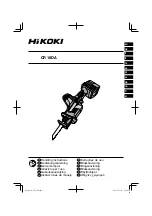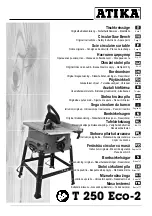
5
English
EXTENSION COrDS
grounded tools require a three wire extension cord
.
Double insulated tools can
use either a two or three wire extension cord. As the distance from the power supply outlet increases, you must
use a heavier gauge extension cord. Using extension cords with inadequately sized wire causes a serious drop
in voltage, resulting in loss of power and possible tool damage. Refer to the table shown below to determine the
required minimum wire size.
The smaller the gauge number of the wire, the greater the capacity of the cord. For example: a 14-gauge cord
can carry a higher current than a 16-gauge cord. When using more than one extension cord to make up the total
length, be sure each cord contains at least the minimum wire size required. If you are using one extension cord
for more than one tool, add the nameplate amperes and use the sum to determine the required minimum wire
size.
guidelines for Using Extension Cords
• If you are using an extension cord outdoors, be sure it is marked with the suffix “W-A” (“W” in Canada) to
indicate that it is acceptable for outdoor use.
• Be sure your extension cord is properly wired and in good electrical condition. Always replace a damaged
extension cord or have it repaired by a qualified person before using it.
• Protect your extension cords from sharp objects, excessive heat, and damp or wet areas.
SPECIFIC SAFETY RULES FOR MITER SAWS
WArNINg:
DO NOT LET COMFOrT Or FAMILIArITY WITH PrODUCT
(gAINED FrOM rEPEATED USE) rEPLACE STrICT ADHErENCE TO PrODUCT SAFETY
rULES. If you use this tool unsafely or incorrectly, you can suffer serious personal injury!
•
Do not operate this miter saw
until it is assembled and installed according to the instructions.
•
If you are not thoroughly familiar with the operation of miter saws
, seek
guidance from your supervisor, instructor, or other qualified person.
•
Mount the tool securely to a stable supporting surface prior to operation
.
Ideally, firmly clamp or bolt your miter saw to a workbench, table, or tool stand at approximately hip height.
•
Use the guards whenever possible
. Check that the guards are correctly positioned, secured,
and working properly.
•
Use only crosscut saw blades.
Use only zero-degree or negative hook angles when using
carbide tipped blades.
IMPOrTANT
:
Do not use thin kerf blades or blades with deep gullets. These can
easily deflect and contact the guard or miter saw table.
•
Use only blades that are the correct size and type specified for this tool.
•
Be sure to use a sharp blade
that runs freely and is free of vibration.
•
Inspect blades for cracks or other damage
prior to operation. Replace a cracked or
damaged blade immediately.
•
Clean the blade and blade flange washers
prior to operation. Again, check for any damage
and tighten the arbor nut securely.
•
Use only the blade flanges specified for this tool.
Recommended Minimum Wire Gauge for Extension Cords (120 Volt)
Nameplate
Amperes
(At Full Load)
Extension Cord Length
25 Feet
50 Feet
75 Feet
100 Feet
150 Feet
200 Feet
0–2.0
18
18
18
18
16
16
2.1–3.4
18
18
18
16
14
14
3.5–5.0
18
18
16
14
12
12
5.1–7.0
18
16
14
12
12
10
7.1–12.0
18
14
12
10
8
8
12.1–16.0
14
12
10
10
8
6
16.1–20.0
12
10
8
8
6
6






































